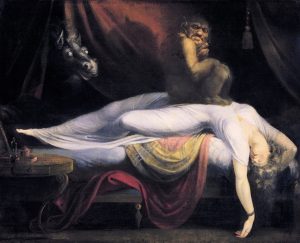
“… in the night time, when she was composing her self to sleep, sometimes she believed the devil lay upon her and held her down, sometimes that she was choaked by a great dog or thief lying upon her breast, so that she could hardly speak or breath, and when she endeavoured to throw off the burthen, she was not able to stir her members. And while she was in that strife, sometimes with great difficulty she awoke of her self, sometimes her husband hearing her make a doleful inarticular voice…”
Incubus or The Night-Mare, Isbrand van Diemerbroeck 1664
This is the earliest description known of sleep paralysis associated with hypnagogic hallucinations. The acutely observant Dutch physician was also the first to note that these highly disturbing dreams occur more often when supine. (1)
Fuseli’s hideous, insolent beastie squatting on the tender belly of the swooned, supine maiden is a lustful and vigorous incubus – a malevolent night demon who would take any opportunity to impregnate a fecund woman and exhaust her.
Saint Augustine reckoned that it was more than a rumour that incubi “often made wicked assaults upon women”. Eight hundred years later, Thomas Aquinas opined against the possibility of children being conceived by intercourse with incubi, but surmised that incubi could change at will to their female equivalents, succubi. A succubus could then sleep with a man, purloin his sperm, and transmogrify back into a now potent incubus, to do considerable damage to female reputations. Victims would claim that the nocturnal creature’s give-away was its over-large and ice-cold penis.
Lillith, she who had intercourse with Adam, was the first succubus on record – in 2400 BC Sumaria; she bore the “spirits and demons that flit about the world”. Women in Middle Eastern maternity wards still wear amulets for protection. (1)
The thoroughly Scottish King James I of England (he of The Bible) was considered a serious and talented writer. His Daemonologie of 1597, rubbishing necromancy, witchcraft, and the ancient arts of black magic, was extensively mined by Shakespeare, particularly for his “Macbeth”: the ironic nuances attached to the Scottish Weird Sisters would not have been lost on contemporary audiences – witches were being burnt.
A witch, of course, travels unseen and swift at night astraddle her broom, her stolen devil’s dick, to do her very worst, to commit her chosen maleficium.
Witches, along with their devilish familiars, the incubi and succubi, added to the nocturnal burden of fear and trepidation felt by most of humankind. Apart from the dangers of tooth and claw, darkness hid our primeval sins, spiritual and temporal, to be denied or admitted, to be kept secret or used to advantage.Religions arose in the ultimately vain attempt to explain the inexplicable, to protect the vulnerable, to offer some semblance of defence against real or imaginary evil, and to punish harshly those that transgressed their multifarious regulations. Religious leaders sought to be all-powerful by channelling their various omnipotent gods, often to exercise to excess their assumed powers and privileges, to wield guilt as a ready weapon to protect their adopted dogmata, and to raise the considerable funds necessary for their livelihoods. It was not in their best interests to disabuse followers of their superstitions.
We now have politicians – “Bless them”, as my Granny would say.
So it is that the terrors of the night continue to spook us. We call up all the nasty things which could conceivably happen to us when it is dark – inevitably rape and violation, murder and violence. Ill-discerned sensations are readily misinterpreted, common sense tends to lose its grip and untoward anxiety is provoked. But, however civilised we think we may be, there are still perfectly obvious places in the world, on our doorsteps even, where our innocent but inappropriate intrusion could be construed as an invitation to victimhood, male or female.
“For Fools rush in where Angels fear to tread.”
There are few children who fail to look under the bed for beasties, who need a glimmer of light in the room, who would prefer the comfort of companionship in sleep, and something cosy and familiar to clutch and suck: I could think of a few adults too.
Howling infants demanding attention are a commonplace accompaniment to new parents’ well-earned rest. There have been many panaceas: a nanny of mine had an infallible one – a dummy dipped in brandy, sprinkled with sugar, yum. A friend of mine told me later that his had dangled him over a gas ring.
In the days of witches and incubi, the quick fix for an upset child, or an adult come to that, was totally logical – a herbal extract of vervain, St. John’s wort and dill. Apart from tasting pretty good, these constituents – verbena officinalis, hypericum perforatum and anethum graveolens – were long-established sedatives. The vervain flavonoids are as powerful as Valium diazepam. The hyperforin of St John’s wort is effective in anxiety and depressive disorders. Dill (from the Saxon dilla, to lull) settles tummies (“gripe water”) and was a familiar soporific (2)(3)(4).
All these ancient and beneficent herbs were commonly grown in English gardens, because Queen Mab was determined to ward off the unsavoury attentions of the wicked hobgoblin Puck and his mates –
With terror to affright him,
She nightshade straws to work him ill,
Therewith her vervain and her dill,
That hindereth witches of their will,
Of purpose to despite him.
Nymphidia, the Court of Fairy (390), Michael Drayton 1627
There we are then – pure dead brilliant – two for the price of one.
We now know the clinical cause of sleep paralysis – the mistiming of REM (random eye movement) sleep, leaving the victim in a state between dream and wakefulness, fully awake but unable to move or breath, hence the terror. To add horror to terror, the paralysis is often accompanied by a hyper-real hallucination, often a creature “carrying out aggressive and/or sexual acts”- the ‘Incubus Phenomenon’. Attacks have been observed to begin occasionally with a short scream, then always followed by muteness, a cold sweat, piloerection, fast pulse rate, high blood pressure, a feeling of suffocation, and, occasionally, the orgasm associated with severe anxiety. (5)(6)
These overwhelming experiences can imprint themselves on the brain’s ‘threat activated vigilance system’, possibly priming over-reaction to any perceived threat in daily life thereafter, the chronic anxiety state (7).
Sleep paralysis is surprisingly common. A recent systematic review has shown that “7.6% of the general population experienced at least one episode over the course of their life”. Lifetime rates were found to be 28.3% in students and 31.9% in psychiatric patients; females slightly predominated (8). Obstructive sleep apnoea with snoring is a known causative factor (9).
The embarrassment of the typically young sufferer, and the general unawareness of the medical profession, are barriers to diagnosis, which is a shame as effective treatments are readily available (5).
It has taken some many thousands of years to shake off our morbid preoccupation with ha-Satan, the anti-Christ and his long trail of acolytes; a preoccupation which had followed our primeval recognition of the inevitability of death (10). Nevertheless, we remain gifted with the brain’s ‘threat activated vigilance system’, embodied within the amygdala. These two small ‘almonds’ recognise imminent danger, initiate appropriate physical reactions, and, crucially, will remember — they become predictive and reactive before we ourselves can put two and two together: that is, of course, if they have previously been given a thorough and intense work-out (11).
Since the unthinkable horrors and terrors of the Second World War, our collective exposure to significant fear and trepidation has been minimal. The Welfare State and increasing prosperity have so cushioned and coddled us that we have become dangerously complacent within the construct of our costly cocoons. We have effectively handed over our individual responsibilities to the archetypal ‘ultimate controller’ (12), the ever-evanescent polity and its necessary greeds.
We have been strongly encouraged to do what we are told to do for the common good, for ‘universal opulence’. As such, our abrogated selves failed to take note of the ‘slow violence’ (13) that was festering within our careless environment, stealing through continents, gathering exponential momentum — until we finally chose to acknowledge the universal presence of a monstrous strike for evil.
Perhaps it’s human penance. Perhaps it won’t happen again. Perhaps we will be ‘all the wiser’. Perhaps….
“You’ve got the crystal ball, dear — you tell me”, as my Granny would say.
I wish.
But, it is becoming all too obvious that we are in line for a third wave of COVID after the significant benefits of the summer months have passed, and the short term protection of the vaccines has waned. We do need to remain aware — to wear masks when appropriate and to continue to take vitamin D 4,000iu daily.
*****
Bottom:
The eye of man hath not heard, the ear of man hath not seen, man’s hand is not able to taste, his tongue to conceive, nor his heart to report, what dream was.
A Midsummer Night’s Dream Act 4, Scene 1 (218) 1595-6
- PMID 28008370 Sleep paralysis and folklore
- PMID 28066246 Anticonvulsant, Anxiolytic, and Sedative Activities of Verbena officinalis
- PMID 18843608 St John’s wort for major depression
- PMID 10844880 The gripe water story
- PMID 29225584 Prevalence Rates of the Incubus Phenomenon: A Systematic Review and Meta-Analysis
- PMID 33262094 Spontaneous Ejaculation: A Focused Review for the Clinicians
- PMID 21601831 Vigilance for threat interacts with amygdala responses to subliminal threat cues in specific phobia
- PMID 27486325 A clinician’s guide to recurrent isolated sleep paralysis
- PMID 31695676 Dreams and Nightmares in Patients With Obstructive Sleep Apnea: A Review
- Becker, Ernest (1973) “The Denial of Death”
- PMID 27092057 Serotonin, Amygdala and Fear: Assembling the Puzzle
- Monitor https://assets.publishing.service.gov.uk
- Davies, Thom (2019) Slow violence and toxic geographies: ‘Out of sight’ to whom?



